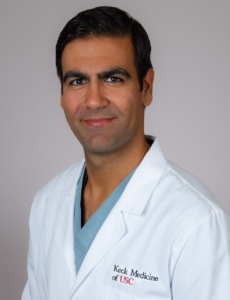Arash Motamed, MD, medical director for operating rooms at Keck Hospital of USC and medical director of sustainability for Keck Medicine of USC, is making Keck Hospital operating rooms more sustainable.

Arash Motamed, MD (Photo/Ricardo Carrasco III)
In early 2021, Motamed started an initiative to phase out the use of a commonly used anesthetic gas known as desflurane.
As popular as desflurane is among anesthetists — mainly for how quickly it takes effect and wears off for patients — it contributes significantly to climate change given its greenhouse gas effect.
“There’s a study that helps people visualize the effect,” Motamed said. “In terms of carbon dioxide equivalents, one hour of average desflurane usage in an operating room has a similar impact as driving 400 miles with an average combustion engine car.”
On the other hand, using an alternative anesthetic named sevoflurane for an hour would be the equivalent of driving approximately 18 miles.
Additionally, sevoflurane offers the same excellent clinical experience for patient care, Motamed said. In fact, sevoflurane, sometimes called “Sweet Sevo,” tends to be less irritating to the airways and comes with a cost advantage.
Armed with this information, Keck Hospital stopped purchasing desflurane in 2022.
Understanding and responding to resistance
Motamed noted that, across the country, there’s general resistance to the swap — despite Scotland’s decision to ban desflurane in early 2023 due to its harmful impact.
“You do something one way all of your life, and then someone says, ‘I don’t want you to do this anymore,’” he said. “It can be scary and challenging, and naturally many oppose. So, we had to get creative in how we got buy-in from our anesthesia providers at Keck Hospital.”
Motamed considered the fact that desflurane comes in small canisters, which are inserted into anesthesia machines. Following a series of educational sessions on the impact of anesthetic gases on the environment, Motamed removed the desflurane canisters from the anesthesia machines and kept the canisters in his office. Anyone who wanted to use desflurane would have to come to the office and sign a form before they could get a cannister.
This allowed providers who wanted to continue using desflurane to do so while giving Motamed the opportunity to educate, one on one, those who came to his office.
“I anticipated that people would only come for the desflurane as a must-have,” Motamed said. “In the first six months, only two people came. After that, the requests stopped altogether.”
That’s when Motamed felt confident to reach out to the pharmacy and to remove desflurane from formulary. To date, no one has asked for desflurane, he said.
The next step: nitrous oxide
Nitrous oxide is commonly used in both pediatrics and adults as an anesthetic. It has significant historical importance in the field of anesthesiology. Motamed explained that it’s not only effective, but also inexpensive, so its popularity is understandable.
“The problem is that most hospitals distribute it through a central pipeline within the building,” Motamed said. “Like any other pipes over the years, these deteriorate to the point where the gas leaks. And it’s not like water or sewage in that when the pipes leak, you soon notice. Furthermore, because it’s cheap, no one really pays attention to it.”
Unfortunately, nitrous oxide’s global warming potential is nearly 300 times that of carbon dioxide over a 100-year period.
“That makes a huge difference in the environment and the quality of air we breathe, especially when you consider that over time, a hospital is going to have this continuous gas leak,” Motamed said. “There have been several studies that showed that potentially up to 90% of nitrous oxide never actually gets to the patient; it just leaks through the pipes into the atmosphere.”
Keck Hospital is unique in the nation for removing nitrous oxide through central supply and cylinders. USC Norris Cancer Hospital is currently in the process of ending nitrous oxide’s use, as well.
Planning for the future
“While sevoflurane is a significant improvement, it’s not completely innocuous,” Motamed said. “So, we looked into our anesthesia delivery equipment for opportunities to improve.”
Soon enough, they found that a major energy and health care brand had created special software for anesthesia machines that would optimize the efficiency of gas delivery and reduce waste.
In a trial run of the software in September 2023, Keck Hospital was able to reduce anesthesia-related waste by 73%.
The impact, when extrapolated across all of Keck Hospital’s main operating rooms, was enough to convince Keck Medicine CEO Rod Hanners and Marty Sargeant, CEO of Keck Medical Center of USC, to move ahead with the software’s implementation on a broad scale.
“The plan is to have the software installed on anesthesia machines in the main operating rooms of Keck Hospital by July,” Motamed said. “If it’s as successful as we hope it will be, then we’ll bring it to other locations.”
— Kate Faye


